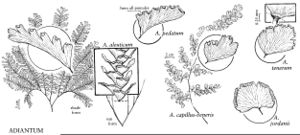Adiantum aleuticum
Rhodora 93: 112. 1991.
Stems short-creeping or suberect; scales bronzy deep yellow, concolored, margins entire. Leaves lax-arching to stiffly erect or pendent, often densely clustered, 15–110 cm. Petiole 0.5–3 mm diam., glabrous, often glaucous. Blade fan-shaped to funnel-shaped, pseudopedate, 1-pinnate distally, 5–45 × 5–45 cm; proximal pinnae (1–)2–7-pinnate; rachis straight, glabrous, often with glaucous bloom. Segment stalks 0.2–0.9(–1.3) mm, dark color entering into segment base or not. Ultimate segments oblong, long-triangular, or occasionally reniform, ca. 2.5–4 times as long as broad; basiscopic margin straight to oblique, or occasionally excavate; acroscopic margin lobed, lobes separated by narrow to broad incisions 0.2–3 mm wide; apex acute to obtuse, obtuse apices divided into ± angular lobes separated by sinuses 0.6–4 mm deep, margins of lobes sharply denticulate. False indusia transversely oblong to crescent-shaped, 0.2–3.5(–6) mm, glabrous. Spores mostly 37–47 µm diam. 2n = 58.
Phenology: Sporulating summer–fall.
Habitat: Wooded ravines, shaded banks, talus slopes, serpentine barrens, and coastal headlands (uncommon)
Elevation: 0–3200 m
Distribution

Alta., B.C., Nfld., Que., Alaska, Ariz., Calif., Colo., Idaho, Maine, Md., Mont., Nev., Oreg., Pa., Utah, Vt., Wash., Wyo., Mexico in Chihuahua.
Discussion
Adiantum aleuticum is disjunct in wet rock fissures at high elevations in Arizona, Colorado, Montana, Nevada, Utah, Wyoming, and Mexico in Chihuahua, and it is disjunct on serpentine in Newfoundland, Quebec, Maine, Maryland, Pennsylvania, and Vermont.
Although the western maidenhair has traditionally been interpreted as an infraspecific variant of Adiantum pedatum, the two taxa are reproductively isolated and differ in an array of morphologic characteristics. Therefore, they are more appropriately considered separate species (C. A. Paris and M. D. Windham 1988). Morphologic differences between A. pedatum and A. aleuticum are subtle; the two may be separated, however, using characteristics in the key. Adiantum aleuticum occurs in a variety of habitats throughout its range, from moist, wooded ravines to stark serpentine barrens and from coastal cliffs to subalpine boulder fields. Although morphologic differences exist among populations in these diverse habitats, they are not consistent. Consequently, infraspecific taxa are not recognized here within A. aleuticum.
Selected References
None.
